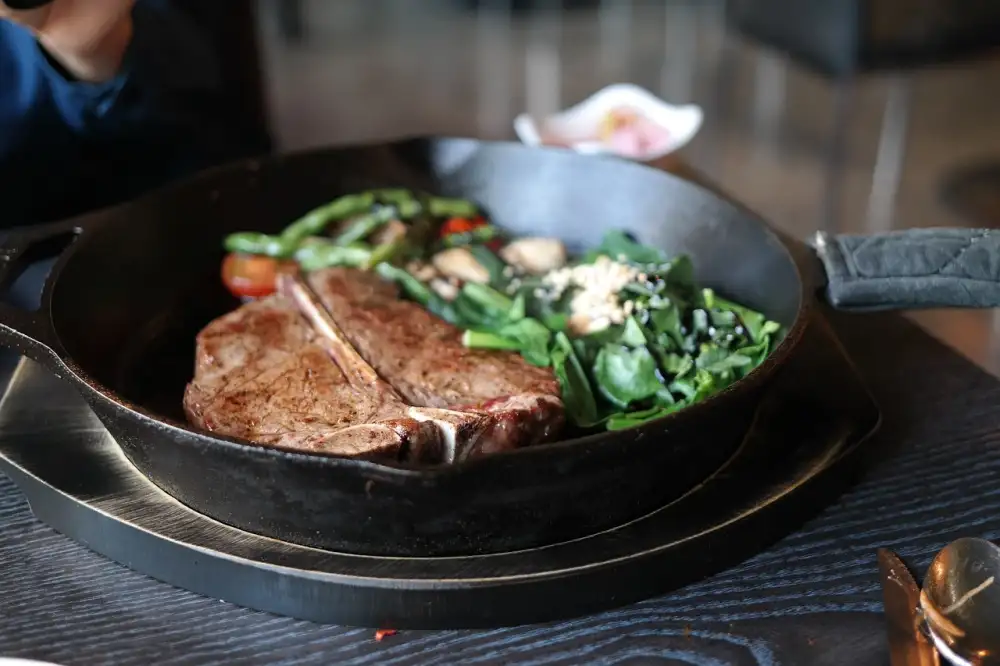Master the Art of Cleaning a Cast Iron Skillet: A Guide to Spotless and Seasoned Cookware

Cleaning a cast iron skillet is an essential skill for any home cook. With proper care and maintenance, your cast iron skillet can last for generations, providing you with delicious meals and excellent cooking results. However, cleaning a cast iron skillet requires some specific techniques to ensure its longevity and prevent rusting. In this guide, we will walk you through the step-by-step process of cleaning your cast iron skillet effectively, leaving it spotless and ready for your next culinary adventure. So let's dive in and master the art of cleaning a cast iron skillet!
Gather necessary materials for cleaning
To clean a cast iron skillet effectively, it is important to gather the necessary materials beforehand. Here's what you'll need:
1. Hot water: This will be used to rinse off any food particles and debris from the skillet.
2. A stiff-bristled brush or sponge: Choose a brush or sponge specifically designed for cleaning cast iron. The bristles should be firm enough to remove stubborn residue without scratching the surface.
3. Salt: Coarse salt, such as kosher salt, works wonders in removing stuck-on food particles and grime.
4. Oil: You'll need a high smoke point oil, like vegetable oil or flaxseed oil, for seasoning the skillet after cleaning.
Having these materials ready will make the cleaning process smoother and more efficient, ensuring that your cast iron skillet stays spotless and well-maintained.
Preparing the skillet for cleaning
Before you begin cleaning your cast iron skillet, it is important to properly prepare it. Start by removing any excess food or debris from the surface of the skillet. You can do this by using a paper towel or a soft brush to wipe away any loose particles.
Next, rinse the skillet with warm water to remove any remaining residue. Avoid using soap at this stage, as it can strip away the seasoning of the skillet. Instead, focus on gently scrubbing the surface with a non-abrasive brush or sponge.
If there are stubborn bits of food stuck to the skillet, you can use a nylon scraper or a wooden spatula to gently scrape them off. Be careful not to use anything too abrasive that could damage the surface of the skillet.
Once you have cleaned the skillet thoroughly, give it a final rinse with warm water to ensure all traces of food and cleaning agents are removed. Make sure to dry it completely before moving on to the next step of seasoning.
Cleaning the skillet with hot water and a brush
Cleaning the skillet with hot water and a brush is an essential step in maintaining its cleanliness. Start by rinsing the skillet under hot running water to remove any loose debris. Then, using a stiff-bristled brush or sponge, scrub the surface of the skillet to remove any remaining food particles. Be sure to scrub all areas, including the sides and bottom of the skillet. The hot water helps to loosen any stuck-on residue, making it easier to remove. Avoid using soap at this stage as it can strip away the skillet's seasoning. Rinse thoroughly to ensure all soap residue is removed.
Removing stubborn residue with salt and oil
To remove stubborn residue from your cast iron skillet, you can use a combination of salt and oil. Start by sprinkling a generous amount of coarse salt onto the surface of the skillet. Then, using a paper towel or a clean cloth, rub the salt into the stubborn spots, applying gentle pressure. The abrasive nature of the salt helps to lift off any stuck-on food particles.
Next, pour a small amount of oil onto the skillet. You can use any type of cooking oil, such as vegetable oil or canola oil. Using a folded paper towel or a clean cloth, spread the oil evenly across the entire surface of the skillet.
Once the salt and oil have been applied, use a brush or sponge to scrub away any remaining residue. Make sure to pay extra attention to any areas that still appear dirty or greasy. The combination of salt and oil helps to break down and loosen stubborn residue, making it easier to remove.
After scrubbing, rinse the skillet with hot water to wash away any leftover salt and oil. Avoid using soap as it can strip away the seasoning on your cast iron skillet.
Remember, removing stubborn residue may require some elbow grease and patience. Don't be afraid to repeat this process if necessary until your skillet is spotless.
By following these steps, you will be able to effectively remove stubborn residue from your cast iron skillet and restore its cleanliness.
Drying the skillet thoroughly
After cleaning your cast iron skillet, it is crucial to dry it thoroughly to prevent rusting. Start by using a clean towel or paper towels to remove any excess moisture from the surface. Ensure that you reach all the corners and crevices of the skillet.
Next, place the skillet on a stovetop burner set to low heat. Allow the residual heat to evaporate any remaining moisture from the skillet. This process helps in ensuring that no water droplets are left behind.
Alternatively, you can also place the skillet in an oven set to a low temperature, around 200°F (93°C), for about 10-15 minutes. This will help in drying out any remaining moisture.
Once you are confident that the skillet is completely dry, remove it from the heat source and let it cool down naturally. Avoid rushing this step as sudden temperature changes can cause warping or cracking of the cast iron.
Remember, thorough drying is essential as even a small amount of moisture can lead to rust formation on your cast iron skillet. Taking these extra steps will ensure that your skillet remains in excellent condition and ready for its next use.
Applying a thin layer of oil for seasoning
Applying a thin layer of oil for seasoning is an essential step in maintaining the quality of your cast iron skillet. After cleaning and drying the skillet, it's important to prevent rust by applying a protective layer of oil. Start by choosing a high smoke point oil such as vegetable or canola oil. Using a paper towel, apply a small amount of oil to the entire surface of the skillet, including the handle. Make sure to coat both the inside and outside thoroughly but avoid using too much oil as it can become sticky. The purpose of seasoning is to create a non-stick surface and enhance the skillet's durability. Once oiled, place the skillet upside down in an oven preheated to 350°F (175°C) for about an hour. This process allows the oil to polymerize and form a protective layer on the skillet's surface. After seasoning, let it cool completely before storing it properly. Remember to repeat this process regularly to maintain a well-seasoned cast iron skillet that will provide you with delicious meals for years to come.
Storing the skillet properly
Storing the skillet properly is essential to maintain its cleanliness and prevent rusting. After cleaning and drying the skillet, make sure it is completely cool before storing. Avoid stacking other cookware on top of it, as this can cause scratches. To prevent moisture buildup, place a paper towel or cloth inside the skillet to absorb any excess moisture. Finally, store the skillet in a dry place with good air circulation, such as a cupboard or shelf. By following these storage tips, your cast iron skillet will stay in great condition for years to come.
In conclusion, mastering the art of cleaning a cast iron skillet is essential for maintaining its longevity and ensuring optimal cooking performance. By following the steps outlined in this guide, you can keep your skillet spotless and seasoned for years to come. Here are some additional tips for maintaining a clean cast iron skillet:
1. Avoid using harsh detergents or abrasive scrubbers that can strip away the seasoning.
2. Always dry the skillet thoroughly after cleaning to prevent rusting.
3. Store the skillet in a cool, dry place to avoid moisture buildup.
4. Regularly re-season your skillet by applying a thin layer of oil after each use.
5. Use your cast iron skillet regularly to maintain its seasoning and prevent food from sticking.
By incorporating these tips into your cleaning routine, you'll be able to enjoy the benefits of cooking with a well-maintained cast iron skillet for many delicious meals to come!
Published: 09. 12. 2023
Category: Home



